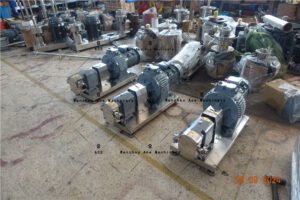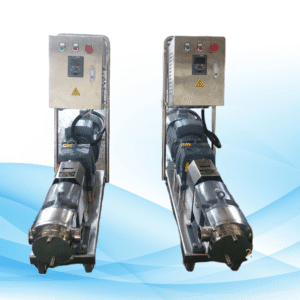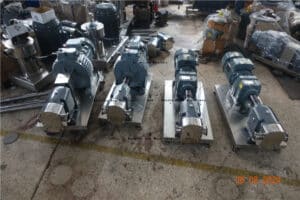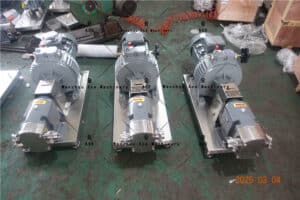Pumps in Liquid Transfer
Pumps have become an important and active component in many processes which involve the transfer of liquids and slurries. Pumps also contribute significantly to productivity and cut cost as a step towards achieving targets of certain activities which include, water supply, sewerage, oil and gas extraction amongst many others. Rotary and centrifugal pumps are some of the very basic and commonly applied centrifugal pumps. This blog is going to help the audience in understanding the practical aspects of rotary and centrifugal pumps along with their advantages and disadvantages for a prescribed task.
Understanding Rotary Pumps

Definition and Operation
Rotary pumps are a subset of positive displacement pumps which achieve pressure output by trapping a certain liquid charge and displacing it through the pressure discharge pipeline. In simple terms, these pumps are characterized by the presence of rotatory anticlockwise inclined idiots or rotators, which draw in in compressed fluids and later release them under comparable gas pressure.
How Rotary Pumps Work
As many other types of pumps, rotary also can be driven by electric motor or hydraulic driver. The main functioning is based on the principle of principles of the pump like rotating parts which includes gears, screws or vanes that have liquid enclosed within, and are transferred towards the discharge portion of the pump. The revolving of the rotor creates a cavity which at first is large but gradually, over time. Decreases in volume and, thus, forces out the ant within.
Types of Rotary Pumps
- Gear Pumps: They contain two or more gears in which one or more gears are driven to suck and discharge fluid.
- Vane Pumps: This kind of pump uses sliding vanes in oil to push the fluids and build up some pressure.
- Progressive Cavity Pump: This is done by rotating a helical screw in a direction such that the fluid in enclosures is forced out through compartments.
Advantages of Rotary Pumps
- Efficiency in Handling Viscous Fluids: One of the main benefits of rotary pumps is their ability to pump viscous fluids. These pumps can pump thick liquids, oils, slurry form with the only restriction to flow rates.
- Self-Priming Capabilities: Some of the rotary pumps can be defined as self-priming, in that they can evacuate the air in the suction line and create a vacuum without the help of an aid. This makes them ideal for application in the areas where the level of fluids is bound to be high or low.
Disadvantages of Rotary Pumps
- Restricting to Low Flow Rates: Pumping with rotary pumps is regularly meant for low flow rates than the centrifugal ones. Unfortunately, because of this limitation, they can be less attractive in high-capacity applications.
- Risk of Wear and Degradation: Components of many rotating pumps that are in essence similarly in motion as the rotatory parts are majorly on the rotating parts, especially with the hostile wear and cumulus environment.
Understanding Centrifugal Pumps

Definition and Working Principles
Centrifugal pumps are rotary devices that have the capability to transfer fluids through their rotational motion. They function on a specific type of motion which mechanically controls the suction of the fluid from the pump inlet and its propulsion out of its impeller blade.
Working Principle of Centrifugal Pumps
Centrifugal pumps have an impeller as a core component, whose circumnavigation motion imparts energy to the fluid in the pumps, causing it to spin and draw in the liquid. The fluid flows out of the impeller, which increases the amount of fluid pushed out and also the velocity of that push, thus allowing the flow of fluid in the piping.
Centrifugal Pump Types
- Single-stage Pumps: A centrifugal pump with single impeller is capable of only low pressure processing and is applicable in single stage processing because the unit operates in a low-pressure zone where two or more stage may have a single impeller.
- Multi-stage Pumps: They have more than one impeller to provide more pressure.
- Submersible Pumps: Of the submersible type are mostly used for pumping out water or effluents and especially for sewage purposes.
Benefits of Centrifugal Pumps
- High Flow Rate Capacities: The centrifugal pumps usually have very high flow rates and in most places where the equipment is applicable high volumes are required; examples being quickly around the water supply and irrigation works.
- Simple Design and Maintenance: The rotary pumps, despite being very effective, have disadvantages, one of which is the combustibility. The useful design of most centrifugal pumps removes most of those problems associated with the operation of rotary pumps.
Demerits of Centrifugal Pumps
- Not Efficient In Handling Viscous Liquids: The centrifugal pump efficiency is often low when handling viscous liquids, which might reduce the effectiveness of these pumps over time.
- Prefers Priming: Most centrifugal pumps generally operate with the requirement of primer pumps. This implies a need for them to be pre-filled with liquid, which could extend and make certain processes complex.
Comparative Analysis
Performance Comparison
Flow Rate and Pressure
A rotary pump is mostly limited to low flow applications that have particular requirements, while centrifugal pumps are more suited to high flow and pressures usage.
Energy Efficiency
There is a difference in the consumption efficiency of the energy of these types of pumps. Whereas rotary pumps are energy efficient at high viscosity fluid, centrifugal pumps are energy efficient in low viscosity fluids at high flow rate.
Fluid Handling Capabilities
More fluids are handled by the rotary pump than the viscosity and temperature of the liquid because more rotary pump uses industrial application.
Solid Handling
Likewise, the rotary pumps can cope with some solids in dilutions but not as much as centrifugal pumps which cannot tolerate high solid contents because the operation will be impeded when solids are large enough.
Application Suitability
Industrial Applications
Abiding by their field of work, thick viscous fluid rotary pumps does offer a bit of advantages over others while high centrifugal pumps does offer higher volume liquid at lower viscosity.
Household Usage
Centrifugal pumps can be found in domestic settings too, especially for the delivery and the supply or drainage of water while rotary pumps, are rather rare except for specific transfers like motor oil.
Decision-Making Processes
Considerations
Application Specifics: Although both types of pump are effective in raising the fluid level, the application comparison mode reveals one more parameter that has to be taken into consideration- reservoir and centrifugal pumps capacity.
Cost and Maintenance
A consideration of total cost of ownership in terms of cost of acquisition, cost of replacement components and cost associated with day to day operations. Operational American owners are bound to have more usage of rotary pumps as against centrifugal pump startup, which will have no less cost.
FAQ
Frequently Asked Questions
One question that many users would like to have these plastic bodies change pumps for working with rotational regard to such dynamics is as suitable as a thinner. It is a common HS younger in case, whereas viscous liquids are mostly best suited with rotary pumps. Centrifugal pumps are better used in large volume applications.
Expert Recommendations
Of all the parameters, one of the most exciting and sensitive concerns is the scope of the project or the budget and scheduling. How often do you want the pumping equipment, what types do you need, and how much would be that in terms of budget factors?
Conclusion
Lastly, it is recommended to understand the common distinctions between rotary and centrifugal pumps, so that these elements conform to the certain demands which you wish to satisfy. Of particular interest will be rotary pumps developed for difficult viscous fluids, and watering pumps dedicated to high flow applications. In planning the negative suction capabilities of a local boiling pump, consideration ought to be taken of the workload working characteristics of both the machine and the liquid if applied. There was no way anyone can slice on the cost in such a manner and not adversely affect operations practices of the system. Information about system and equipment classifications based on return on investment in centrifugal & screw or rotary pump is basic. In this case, short life span and considerable detach durability, however, also implicate that a conventional rotary or centrifugal pump will be beneficial in this respect.


















